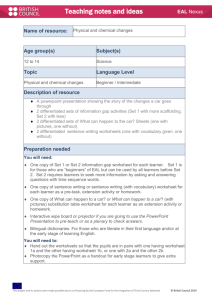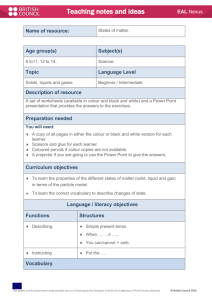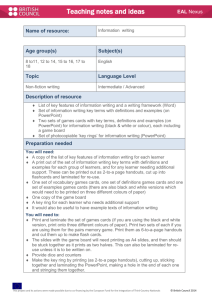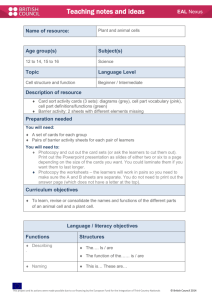Extended version
advertisement
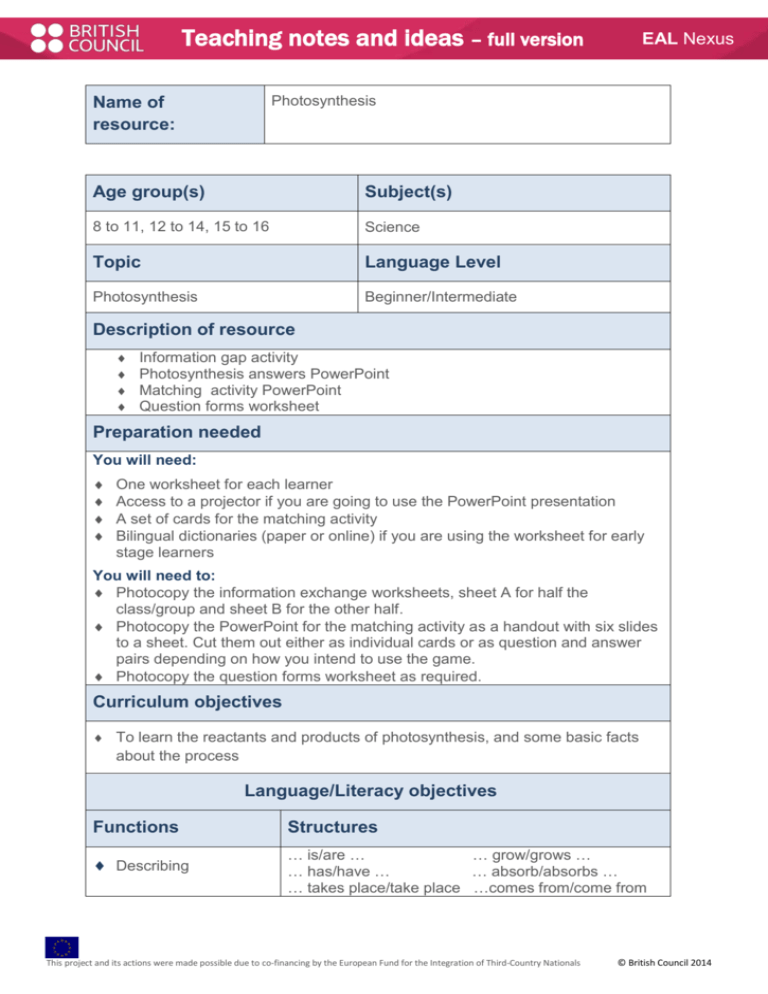
Teaching notes and ideas – full version EAL Nexus Photosynthesis Name of resource: Age group(s) Subject(s) 8 to 11, 12 to 14, 15 to 16 Science Topic Language Level Photosynthesis Beginner/Intermediate Description of resource Information gap activity Photosynthesis answers PowerPoint Matching activity PowerPoint Question forms worksheet Preparation needed You will need: One worksheet for each learner Access to a projector if you are going to use the PowerPoint presentation A set of cards for the matching activity Bilingual dictionaries (paper or online) if you are using the worksheet for early stage learners You will need to: Photocopy the information exchange worksheets, sheet A for half the class/group and sheet B for the other half. Photocopy the PowerPoint for the matching activity as a handout with six slides to a sheet. Cut them out either as individual cards or as question and answer pairs depending on how you intend to use the game. Photocopy the question forms worksheet as required. Curriculum objectives To learn the reactants and products of photosynthesis, and some basic facts about the process Language/Literacy objectives Functions Structures Describing … is/are … … grow/grows … … has/have … … absorb/absorbs … … takes place/take place …comes from/come from This project and its actions were made possible due to co-financing by the European Fund for the Integration of Third-Country Nationals © British Council 2014 EAL Nexus Asking questions Which part of …? Where …? Which part …? Is/Does …? What is/does …? What sort/kind of …? Vocabulary absorb, carbon dioxide, chlorophyll, chloroplasts, equation, glucose, leaf, light energy, oxygen, photosynthesis, respiration, root, soil, starch This resource could be used: whole class as differentiation within class one to one or small group Ideas for using the resource What to do Information gap activity Set up the PowerPoint presentation and hand out the information gap worksheets. Make sure that you hand them out so that the pupils are in pairs with one having worksheet A and the other having worksheet B. Tell them not to look at each other’s sheets. Learners work independently initially and try to label the diagram and then answer the questions. After completing as much as they can independently, learners check their answer with their partner by asking questions. This is an information exchange activity. You can use the PowerPoint to give pupils some useful phrases to help as they discuss the work. The PowerPoint gives the answers so that learners can mark their work. It is important that they do not show each other what is on their worksheet as the idea is to discuss the answers together. Matching activity The matching activity can be used in two ways. It can be used as pairs cards where learners need to match questions and answers. Alternatively, the slides can be cut out with the question and answer joined together. Learners can then ask each other the questions. Question forms worksheet This worksheet is designed to be used by those learners who are relatively new to English and is a way of introducing new vocabulary. The wordlist could be completed as a homework before the lesson so that the learners can access the lesson. The questions are designed to be completed after they have done This project and its actions were made possible due to co-financing by the European Fund for the Integration of Third-Country Nationals © British Council 2014 EAL Nexus the pair work activity so that they already know the answers to the questions and are able to focus on sentence construction. Other ideas for making the best use of this resource Learners could revisit the activity as a starter for the next lesson just using the PowerPoint and trying to answer all the questions with no help. Possible extension activities Learners could try to write their own questions using wh- words on photosynthesis after being provided with the answers. They can be given clues to help if needed – for example, they could be told the first word of the question. The answers could be given as single words or short phrases on the worksheet but do not make sense on their own. Learners could write down the answers in complete sentences using the words in the question to help them. This project and its actions were made possible due to co-financing by the European Fund for the Integration of Third-Country Nationals © British Council 2014
